 Museum of Terror Vol. 1- Tomie 1
Museum of Terror Vol. 1- Tomie 1Publisher: Dark Horse
Script and Artwork: Ito Junji
Translation: Naomi Kokubo
I believe the sales for this series have been somewhat disappointing for Dark Horse, which confounds and confuses me to no end. Ito Junji's deliciously repulsive work just doesn't seem to have found the audience it deserves in North America. A curious lapse in taste by manga consumers. But forget that for now. Instead, let us praise Tomie... both the manga and the character!
Tomie. Who or what is Tomie, exactly? She wears the shape of an extraordinarily beautiful young girl, one so alluring that men are driven to obey her every whim until the pain of loving her becomes so strong they must kill her and chop her into tiny bits. But each piece of Tomie has the power to regenerate into a completely new Tomie.
It's difficult to know what to make of Tomie. She's both victim and victimizer. She views men as playthings, is possessed of both an extreme narcissism and a complete ruthlessness. But due to the serial nature of her stories, and their relative lack of continuing protagonists, Tomie becomes the centerpiece and so goes from inhuman monster to anti-hero.

Our first glimpse of Tomie is
this innocent "snapshot" pose.
She's even sympathetic. While Tomie's siren-like gift/curse frequently proves her own undoing, it's something she didn't ask for. It may even be something she can't control- maybe this ability drove a perfectly decent human being completely over the edge. She destroys lives, but frequently does this out of revenge. Many of her victims come to grief because they themselves occupy a sort of moral gray area.

You'd do this for your best friend,
too... wouldn't you?
Think about what life must be like for Tomie, the girl with only one true friend. What would you do if you had an affair with a teacher behind your boyfriend's back and the the two of them not only caused your death but then involved your entire high school class in a grisly cover-up? While the girls keep a look out, Tomie's teacher has the boys strip and saw her into forty-two pieces. They then wash away their guilt in a nearby river, and everyone takes a part of Tomie home to dispose of.
Tomie's best friend, Reiko, gets the heart, which she tosses from a bridge. Imagine everyone's surprise the day following Tomie's funeral when she shows up for class, no worse for wear, apologizing, "Sorry I'm late."
It's really hard for me to feel too much sympathy for the teacher when he's carted off to the mental hospital that very same day.
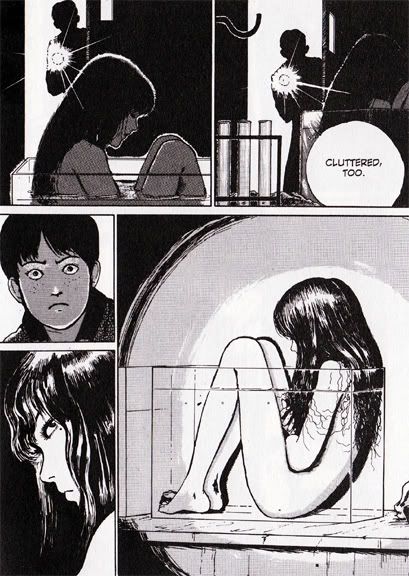
Why didn't this happen to me
when I was in the hospital as
a teen?
Writer/artist Ito Junji presents a relatively benign Tomie in the first tale, simply titled "Tomie." He uses one of his signature storytelling devices by having it narrated by the elfin, short-haired Reiko. By the second story in this volume, "Tomie Pt. 2 (Morita Hospital Episode)," Tomie's personality becomes more manipulative and sinister.
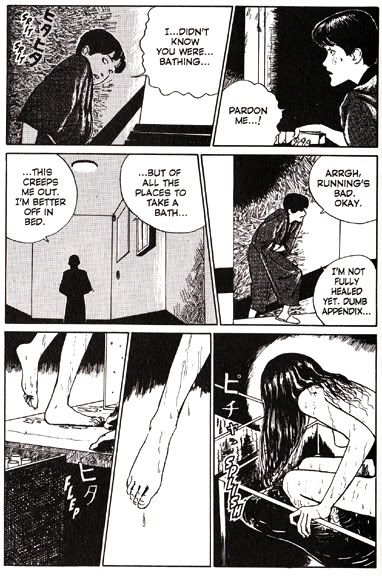
Tomie demonstrates a novel
way of cleaning your home
aquarium.
Here, we find Tomie involved in a love triangle that includes a severely ill classmate (another elfin, short-haired girl) and her semi-boyfriend. When the boyfriend murders Tomie, her kidney is transplanted into the sick girl... with horrific results.
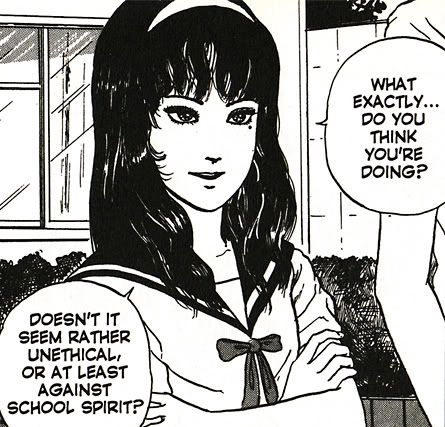
Tomie, take 3!
The crazed teacher from the first story makes a reappearance, this time claiming to be Tomie's father. Ito's nasty shorts are true horror tales in there's rarely a chance for happy endings. He also proves himself a master of foreshadowing. Discovering that Tomie is the unfortunate girl's organ donor provides the reader with a dreadful sense of anticipation... something Ito skillfully pays off with a nightmarish sequence involving an emergency Tomie-dectomy.
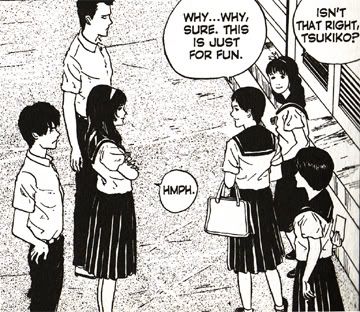
Tsukiko and customers face down
Tomie and her henchmen.
As grisly as that story is, the whole saga really blossoms with the next sequence starting with "Photo." Easily the best story in the book, "Photo" features a ethically compromised protagonist, a budding photographer who cheerfully and matter-of-factly explains:
I'm Tsukiko Izumisawa. I hang around with the photo club. I also sell dreams to the pathetic and lovesick. My friends tell me which boys they're into. I snap their pictures, then charge through the teeth.
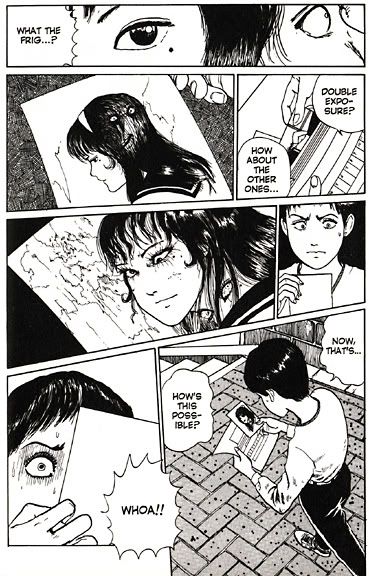
That's Tomie... lovely in person,
but not particularly photogenic.
Tsukiko is yet another elfin, short-haired girl! And unfortunately for her, her little racket falls afoul of the school's new Ethics Club president, the mysterious and lovely Tomie. Tomie begins this story as a very straight-laced (if somewhat conniving) character, always attended by her two bodyguards/fellow club-members.
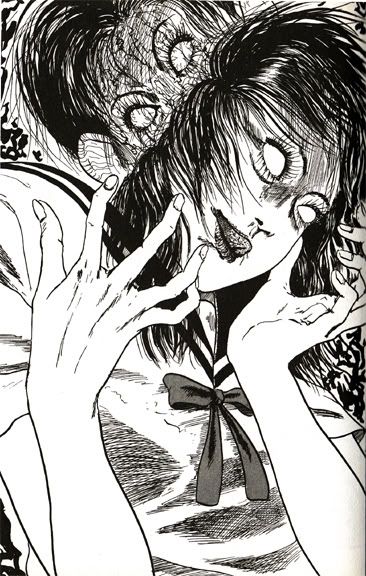
Oh, Tomie! You so crazy!
It doesn't take long for things to morph from an accurate reportage of teen age angst in a sort of pre-Ghost World mode to murder and mayhem... kind of like the movie Heathers, if the title trio weren't just bitchy rich chicks but instead were a single girl with supernatural regenerative powers and a icy heart.
The Tsukiko saga continues for two more installments: the horrific "Kiss," and then the Grand Guignol finale, "Mansion," where we learn of Tomie's origins as Tsukiko confronts her nemesis at her dark, gothic house. It comes complete with moving suits of medieval armor (European-style for that classic haunted house touch) and a mad scientist... plus a secret in the attic. The story ends in a sort of H.P. Lovecraft homage featuring some of the sickest drawings I've ever seen.
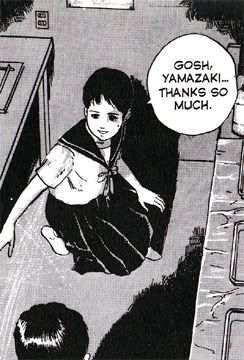
Remember... when pursued by
lovesick killers, hide in a small
room with only one, easily-blocked
exit.
Her story told, Ito abandons the charming Tsukiko for three stand-alone tales of Tomie horror. The first, "Revenge," is a fast-paced tale of mountain climbing adventure that turns cannibalistic when Tomie gets involved. The second is the dreamlike "Waterfall Basin," and the volume concludes with "Painter," where once again we see the maliciously manipulative Tomie putting her skills to bad use.
Ito is a skilled draftsman, working in a unique style. It's moody stuff, completely without those ever-popular manga visual cliches-- the giant eyes, the single sweat droplet, the super-deformed emotionalism. Instead, Ito's art approaches a comics universality. This is a book even the most diehard anti-manga hater could pick up and enjoy. Ito grounds his characters and their looks in solid reality, which amplifies the "special effects" moments. For the most part, Ito's cast looks natural and realistic. You know, until they morph into grotesqueries.
Ito's line quality is sometimes dithery, especially in the earlier stories. But as the book progresses, he becomes more artistically assured. By the time he's drawing mutated monsters and fetal Tomie-creatures that cackle gleefully as they attempt to seduce even from within experimental jars, Ito proves himself a modern master of horror imagery, easily the equal of such popular American horror artists as Graham Ingels and Bernie Wrightson.
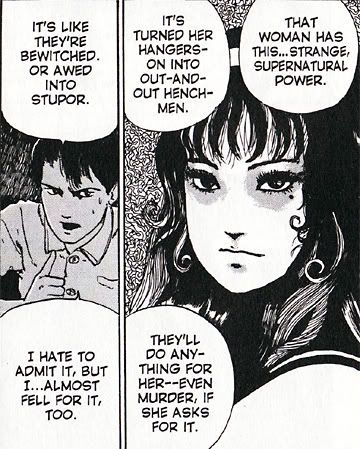
You know you're supposed to
read this stuff from right-to-left,
right? Go back and read the previous
pages and they'll finally make sense.
If he has a flaw, it's in the stiffness of his posing and reliance on similar body types. Most of his male characters are spidery, spindly guys with longish arms and legs. And of course, he seems obsessed with those elfin, short-haired girls.
Those minor points aside, Ito is one of comics' finest genre writers, and his plotting abilities are second to none, especially in these short-form stories. Skillfully using narrative framing devices and flashbacks to enhance the horror, Ito keeps his stories moving at a rapid pace. Horrors build on horrors, but Ito also slips in little moments of humor, such as when Tomie's Ethics Club (that in itself is a delicious irony) henchmen tie Tsukiko to a table in her room, then have to perform impromptu surgery on their goddess, only to botch it. In a uniquely Japanese touch, they carry the results from the bedroom in one of the ubiquitous plastic combini (convenience store) bags Tomie earlier used to tote snacks.

It's also a good idea to confess
your love to the guy who's about
to garrote you. He'll still kill you,
but at least he'll feel guilty about it
later.
The Tomie 1 stories are disturbing yet fun, shot through with the freaky yet compelling logic/illogic of dreams. And because there's no continuing central character beyond Tomie (or to a lesser extent, Tsukiko), the reader becomes drawn to the monster-girl, imbuing her with qualities and depth beyond mere villainess. Especially since we never really learn which Tomie is the real Tomie; for all we know, the primary Tomie was a perfectly normal girl despite her mutation and it's merely the trauma of being murdered and reborn repeatedly that causes her to lash out and destroy men.
The translation by Naomi Kokubo and Eric-Jon Rossel Waugh (who did the localization) deserves a special mention because it is absolutely superb, giving the characters believable and distinct voices without relying on slang or cutesy verbal devices. The teens sound like teens, the doctors sound like doctors and Tomie sounds like nothing you've ever encountered- by turns charming, devious, innocent and then completely inhuman and monstrous. Chris Claremont wishes he could write dialogue this natural.
An ideal translation doesn't simply substitute one language for another; it amplifies and complements the source material and the author's original intent. I wish I could read this in the original Japanese, but I can hardly imagine it to be any finer than Kokubo's work here.
Ahhh... Tomie... how I love your stories. Now please don't kill me!

No comments:
Post a Comment